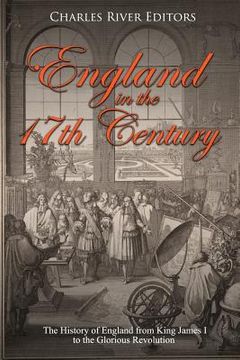England in the 17th Century: The History of England from King James I to the Glorious Revolution (en Inglés)
Reseña del libro "England in the 17th Century: The History of England from King James I to the Glorious Revolution (en Inglés)"
*Includes pictures *Includes contemporary accounts *Includes online resources and a bibliography for further reading 17th century Europe, particularly its latter years, is often hailed as the beginning of the Enlightenment as nations across the continent experienced a surge in innovation and scientific progress, a period also commonly referred to as the Age of Reason. There was English natural philosopher, Francis Bacon, whose book Novum Organum challenged Aristotelian philosophy and stressed the significance of inductive reasoning. Bacon's ideas, which emphasized observation and the implementation of various premises to form conclusions, was later referenced by famed French mathematician René Descartes. However, time and time again, grossly incompetent and seemingly diabolic rulers had come to power through the rigged regal system. For starters, there was John, King of England, the real-life inspiration of the evil and infantile lion in the beloved Disney animation Robin Hood, a retelling of the tale with anthropomorphic animals. King John was said to have been power-hungry but politically feckless, and a sadistic soul who delighted in cruel and inhumane torture. The king did away with nearly everyone that had slighted him, including his own nephew, his political rival. This was a man whose reputation was so horrid, chroniclers and academics have summed him up as an "absolute rotter." King James I would continue to reign, and England has more often been faced with the claims of competing kings and queens than with a period of no monarch at all. The major exception to that rule came in the 11 years between 1649 and 1660, when England was a republic. Following the disastrous reign of Charles I and the civil wars that led to his execution, Parliament and the army ruled England. England's republican experiment started out as a work of collaboration and compromise; lords, army officers and members of Parliament (MPs) worked together to find a political settlement that did not include the despised royal House of Stuart. Nonetheless, religious and political division made collective rule unworkable, and ultimately, one man emerged from the chaos to rule the country. He had risen from a humble background to become the leading general of the Civil Wars, and as a man of staunch beliefs and ruthless pragmatism, he controlled England from 1653-1658 under the title of Lord Protector. In essence, he was a king in all but name. Cromwell's death would lead to a restoration of the royal line, but an uprising of a completely different nature would soon unfold on English soil - the Glorious Revolution, an intriguing story of a power war exacerbated by ruthless ambition, under-the-table plotting, and the treachery of familial betrayal. In 1678, a sinister scheme to assassinate King Charles II was unearthed, sending the public into a frenzy of mass panic. Fingers were pointed at the Catholics, who had been accused of concocting the elaborate conspiracy, and this very event would intensify the white-hot flames of the Anti-Catholic hysteria that was already running unchecked within the nation. 7 years later, the openly Catholic King James II rose to the throne, and needless to say, the largely Protestant public was anything but pleased. As the people slowly turned against him, the king's daughter, Mary, and her husband, William of Orange, watched across the English Channel from a distance. The people were begging for change in a broken system, and something drastic had to and would be done. England in the 17th Century: The History of England from King James I to the Glorious Revolution examines some of the most tumultuous periods in England's history. Along with pictures depicting important people, places, and events, you will learn about 17th century England like never before.

